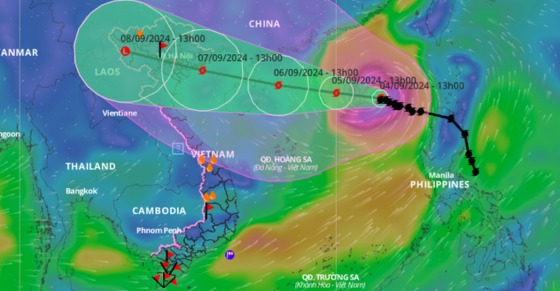Regulations on the levels of natural disaster risks of typhoon, tropical low pressure in Vietnam
Vietnam is entering the peak season of storms and typhoons in 2024. Below are the regulations on the levels of natural disaster risks of typhoon, tropical low pressure in Vietnam

Regulations on the levels of natural disaster risks of typhoon, tropical low pressure in Vietnam (Image from the internet)
Regulations on the levels of natural disaster risks of typhoon, tropical low pressure in Vietnam
Based on Article 18 of the Law on Natural Disaster Prevention and Control 2013, the regulations on the levels of natural disaster risks of typhoon, tropical low pressure are as follows:
- Natural disaster risks are categorized into levels. The risk levels of natural disasters serve as a basis for warning, directing, commanding, responding to, and mitigating the consequences of natural disasters.
- The criteria for categorizing the risk levels of natural disasters include:
+ Intensity or danger level of the natural disaster;
+ Impact scope;
+ Potential damage to life, property, infrastructure, and the environment.
- The Prime Minister of the Government of Vietnam provides detailed regulations on the risk levels of natural disasters.
* Additionally, according to Article 4 of Decision 18/2021/QD-TTg, the determination of the risk levels of natural disasters is regulated as follows:
- Natural disaster risks are classified based on the intensity, impact scope, directly affected areas, and potential damage caused by the natural disaster.
- The risk levels of natural disasters are determined for each type of natural disaster and announced along with the contents of the forecast and warning bulletin about the natural disaster.
- The risk levels of each type of natural disaster are categorized into a maximum of 5 levels and are associated with a distinct color on various maps, increasing according to the risk level of the natural disaster:
+ Level 1 light blue represents low risk;
+ Level 2 light yellow represents medium risk;
+ Level 3 orange represents high risk;
+ Level 4 red represents very high risk;
+ Level 5 purple represents disaster-level risk (Appendix XII of Decision 18/2021/QD-TTg).
- The risk levels of two or more natural disasters occurring simultaneously or consecutively can be adjusted up by 1 level based on the impact of the natural disasters; in cases where there is a risk of serious damage to people and property, the risk level can be considered to be raised by two levels, with the highest being level 5.
In the context of typhoons, tropical low pressures (ATND), Table 2 of Appendix XII attached to Decision 18/2021/QD-TTg specifies the risk levels as follows:
| ATND, Typhoon Levels | Risk Levels | ||||
| ≥ 16 (super typhoon) | 4 | 5 | 5 | 5 | 5 |
| 14 - 15 (very strong typhoon) | 4 | 4 | 5 | 5 | 5 |
| 12 - 13 (very strong typhoon) | 3 | 4 | 4 | 5 | 4 |
| 10 - 11 (strong typhoon) | 3 | 3 | 3 | 4 | 3 |
| 6 - 9 (ATND, typhoon) | 3 | 3 | 3 | 3 | 3 |
| Impact Area | East Sea | Nearshore, Northeastern Coastal Mainland, Northern Delta, North Central, Central Central Mainland | South Central Mainland | Southern Mainland | Northwestern, Viet Bac, Central Highlands |
Regulations on basic measures to respond to typhoons in Vietnam under the Law on Natural Disaster Prevention and Control 2013
According to Clause 1, Article 26 of the Law on Natural Disaster Prevention and Control 2013 (amended in 2020), based on the type of natural disaster and its risk level, the National Steering Committee for Natural Disaster Prevention and Control, the National Committee for Search and Rescue, and the various levels of the Steering Committee for Natural Disaster Prevention and Search and Rescue will decide to implement one or more appropriate measures for responding to typhoons as follows:
Based on the types of natural disasters and levels of natural disaster risks, the Central Steering Committee for Natural Disaster Prevention and Control, the National Committee for Search and Rescue and commanding committees for natural disaster prevention and control and search and rescue at all levels shall decide to select one or several of the following measures as appropriate:
- Evacuate people from dangerous areas where safety cannot be ensured; focus on implementing measures to ensure the safety of people, especially vulnerable groups in emergency situations.
- Move ships, boats, and aquaculture equipment from dangerous areas; organize the counting and guidance of docked ships or implement other measures to ensure their safety.
- Implement measures to ensure the safety of houses, offices, hospitals, schools, warehouses, facilities, and economic, security, and defense structures.
- Proactively implement measures to protect production.
- Inspect, detect, and handle incidents in natural disaster prevention structures, critical socio-economic and defense works.
- Monitor, guide, and proactively implement restrictions or bans on people and vehicles from entering dangerous areas on rivers, seas, heavily submerged areas, areas with a risk of landslides due to rains or flows, and other dangerous areas.
- Ensure transportation and communication meet the requirements for directing and commanding natural disaster prevention and control.
- Conduct search and rescue activities, treat the injured, provide food, medicine, drinking water, and other essential supplies in isolated areas, severely submerged areas, and evacuation sites.
- Ensure public order and social security, protect state and people's properties in disaster-affected areas.
- Urgently mobilize and comply with urgent mobilization decisions regarding human resources, materials, equipment, and essential supplies to promptly respond to natural disasters.
- Cases of land rent exemption and reduction under the latest regulations in Vietnam
- Economic infrastructure and social infrastructure system in Thu Duc City, Ho Chi Minh City
- Regulations on ordination with foreign elements in religious organizations in Vietnam
- Increase land compensation prices in Vietnam from January 1, 2026
- Determination of land compensation levels for damage during land requisition process in Vietnam
- Who is permitted to purchase social housing according to latest regulations in Vietnam?
-

- Notable new policies of Vietnam effective as of ...
- 16:26, 11/04/2025
-
.Medium.png)
- Notable documents of Vietnam in the previous week ...
- 16:21, 11/04/2025
-
.Medium.png)
- Notable documents of Vietnam in the previous week ...
- 16:11, 02/04/2025
-
.Medium.png)
- Notable new policies of Vietnam to be effective ...
- 16:04, 02/04/2025
-
.Medium.png)
- Notable new policies of Vietnam effective from ...
- 14:51, 21/03/2025

 Article table of contents
Article table of contents
